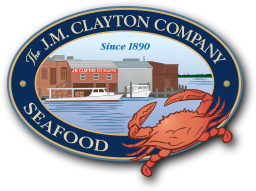OUR HISTORY
A Family Business

The J. M. Clayton Company was founded in 1890 by Captain John Morgan Clayton (known as “Captain Johnnie”) and has remained in the family for over four generations. The oldest working crab processing plant in the world, it began as a small oyster shucking and packing operation in Hoopersville, Dorchester County, Maryland. Located at the end of a 1,000-foot wooden causeway, the original Clayton’s facility packed seafood and fresh vegetables for delivery by steamboat to Baltimore, the only market for their products at the time.
Within a few years, Captain Johnnie began picking and processing the delectable Chesapeake Bay blue crab, packing their crabmeat under the label name, “Epicure.”
Seeking better access to supplies, telephone service, and multiple modes of transportation, Captain Johnnie relocated his company in 1921 to its current Cambridge setting off the Choptank River. Not wanting to leave his skilled labor force behind, John Clayton moved entire families with him, including ancestors of some workers who are still employed at the J. M. Clayton Company. Loading everyone and everything onto Clayton’s large workboat, the Epicure, John Clayton set sail for what remains today a legend in the seafood packing business.
Over the years, the entire Clayton family worked at the packing plant. Captain Johnnie passed the business along to his son-in-law, who, along with several other family members, ran the J. M. Clayton Company until grandson J. Clayton Brooks took over as president in 1969.
Today, Clayton’s is operated by three brothers, Jack, Bill, and Joe Brooks, and Clay Brooks, the first of the fifth generation, who, following in the footsteps of their great grandfather Captain John Morgan Clayton, have made the J. M. Clayton Company an extraordinary Chesapeake Bay landmark.
Rich in History

The J. M. Clayton Company was the first crabmeat processing plant in Dorchester County and one of the first on the Chesapeake Bay to pick crabs and shed soft crabs. In 1938 Clayton’s purchased Goose Creek Seafood in Toddville, Maryland in order to obtain a steadier supply of crabmeat and oysters. By the early 1940’s, Clayton’s began picking and processing crabs year-round, getting their off-season crabs from the warmer Virginia and North Carolina waters. Providing work for employees throughout the year allowed Clayton’s to better hold on to their experienced and reliable crab pickers.
Crabs were in plentiful supply through the industry’s peak in the 1930’s and the 1940’s, and also during World War II when crabmeat was excluded from rationed food items. Immediately following the war, Clayton’s was operating at the height of production, employing 125 crab pickers, 95 oyster shuckers, and a support crew of 30.
In 1957, the J. M. Clayton Company began using the pasteurizing process to naturally preserve crabmeat. Employing the method invented by Louis Pasteur, Clayton’s was able to extend the shelf life of crabmeat, a revolution in the crab packing industry. Packing plants now processed crabmeat year-round and inventoried it until the seasonal market arrived. The same pasteurizing process is still widely used today. At Clayton’s all our pasteurized crabmeat is prepared naturally without chemicals, additives or preservatives.
The J.M. Clayton Company has survived over the years through sound management combined with their efforts in establishing working relationships with local watermen and recruiting the mainstay of their operation – experienced crab pickers. From the height of Maryland’s crab picking industry when over 60 businesses were in operation, Clayton’s is currently just one of 20 left and the only one remaining on the water in Cambridge.
The “Quik Pik” crab picker

Responding to a shortage of skilled crab pickers, J. Clayton Brooks, along with business associates Calvert Tolley and Ted Reinke, invented the world’s first automatic crab picking machine. Named the “Quik Pik”, it was patented in 1973 after 10 years of perfecting the mechanized picking process. At one time, 25 businesses from Florida to Maryland were using the Quik Pik to pick their crabs. Although the choice, high-prized lump or backfin meat must still be picked by hand, the Quik Pik is still employed at Clayton’s to efficiently remove crabmeat from the shell. This remarkable machine picks at a speed of 100 pounds of crabmeat per hour. It would take 25 workers to hand pick at the same rate.
